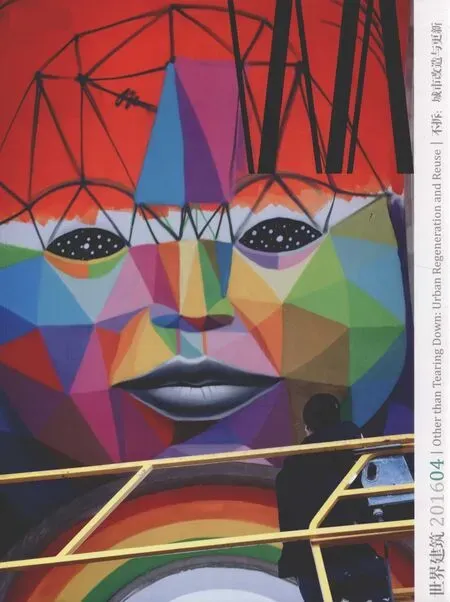居住集合体L,莱阳,山东,中国
建筑设计:汇一建筑
Architects: in:Flux architecture
居住集合体L,莱阳,山东,中国
建筑设计:汇一建筑
Architects: in:Flux architecture

1南立面/South elevation
“城市的特征向来都是由住宅所表现,事实上如果没有住宅的话,城市将不可能存在。”——《城市建筑》,阿尔多·罗西
这是一个城市住宅项目,它是如此的特殊,一个带有明显时代特征、地处一个地级市中心区域空置10多年的烂尾楼的改造。这栋旧楼就像是这个四线小城市的缩影,过去的10多年中,它一直默默耸立在市中心,被遗弃在时代的浪潮当中。时过境迁,新一轮的土地开发爆发,它再次被记起,因为它的位置和曾经寄托于其身的期许。原构造物为一建成后从未使用过的10层办公建筑,这样类似废墟的不良资产是高速城市化所带来的不可预期的结果。对于它的荒废闲置,周边居民用“路冲”等各种“神乎其神”的说法去解释。城市经济快速发展带来了大量的住宅需求,业主期望能在这城市丁字路口空置多年的构造物内植入新的居住功能,而这也提供了城市未来转型与发展的另一种可能。
小户型的居住单元置入在这15,000m2的混凝土构造物中,尺度和功能各异的公共空间穿插于其间。各楼层的公共露台的设置消化了建筑平面不适合居住开发的区域,而这些位于转角“路冲”处的户外公共空间也弱化了原有对于这个地级市来说过于巨大的建筑体量对城市空间的影响,这个空间就像旧时农村居住建筑群中的活动广场般,在垂直向度上提供各楼层住户一个能发生多样活动的公共空间。南向标准化钢结构阳台的设计充分满足了构造的安全性和建造速度的需求,大面宽1.6m的进深的阳台,就像是小户型室内空间的延伸,同时它也减少了南向直射阳光对室内生活空间的直接影响。低楼层的居住单元和城市交接的界面处,在阳台之外又增加了一层穿孔钢板,它过滤了街道活动对私人生活空间的干扰,阳台在此更像是一个半户外的私人空间。透过公共露台和私人阳台的处理,一种新的生活对话发生在建筑和忙碌的城市之间。
在不调整原有的结构柱网的原则下,8个居住楼层分割成了3种共244户居住单元。单元的室内规划避免了单一功能非停留空间的存在。必要的食、住和清洁等生活机能,结合了交通空间,再透过必要的储物空间的配置串联成为一个高弹性的生活综合体,而这些单一功能空间边界的模糊化处理,使得居住空间整体具备了更多使用功能的自主性和更高的效率。



2改造前外景/Exterior view before renovation
3总平面图/Site plan
4.5公共露台/public terraces
"The city has always characterized largely by the individual dwelling.It can be said that cities in which the residential aspect was not present do not exist or have not existed."
— Aldo Rossi, The Architecture of the City
Housing L is a renovation project of an office building that has been abandoned for more than ten years. The construction of the original building was never completed. Located in a fourth-tier city Laiyang, this kind of non-performing assets is an unpredictable result from the high-speed urbanization in China. Recently, as a series of new real estate development gained impetus, this building came to the sight again because of its location and the expectation from the public. The rapid urban development has brought increasing housing demands. The developer expected to transfer this property into a housing. This strategy provides another possibility for urban renewal and transformation in the future.
Along the main street, commercial spaces are maintained and renovated at the first two floors on the plaza level. The water wall and the landscape create a buffer zone between the street and the new two-story high lobby. Besides adding more elevators and public circulation spaces to satisfy egress and efficiency needs, the folding corner spaces on residential floors were opened up and transformed into public terraces. Directly facing the T-junction of roads, these areas are usually considered bad in terms of Fengshui. They were also not suitable for residential units because of the geometry in plans. These public terraces on residential floors, similar to the traditional squares in the rural villages, serve the tenants with places for neighborhood activities.
Located at the central area of this small city,this ten-story building is considered too massive for its surroundings. To satisfy the need for shading as well as outdoor spaces for living, private balconies are added on the southern and southeastern façades. It is like a veil covering the building that creates a new layer of outdoor living zone in between. It also softens the solid wall behind. Along with the public terraces on each floor, these steel balconies of 1.6m in depth transform this building with cliché decor into an urban living place. perforated metal plates are added to the outside of the balconies at the lower three residential floors to reduce the direct impact from the street traffic. This corrugated surface also brings rhythms of colors variations to the facades under daylight. The balcony façade creates a new dialogue between the building and the city. Without modifying the existing concrete structure, three types of 244 residential units (from 22 to 38 square meters)are placed on eight floors. Through the efficient zoning of living, sanitation area and the storage spaces, the compact layout of the dwelling unit makes the living space more flexible for modern urban living. All functions are clearly defined, and yet the spaces maintain a sense of continuity and cohesiveness.

6公共空间示意图/public space
7五层平面图/Floor 4 plan
8七层平面图/Floor 6 plan
9阳台/Balcony
10公共露台/public terrace
1该项目及周边区域此前面临的突出问题是什么?
投资与需求间的落差经常给城市发展带来问题,城市里烂尾楼或鬼楼的出现也是伴随着高速城市化所来的现象。这栋闲置超过了10年、10层的商业办公大楼所占据的地块就像是一座隔离于城市日常生活的孤岛,一块地图上的空白。它原先被设想为当地高档次的写字楼,却成了城市里工程车销售及汽配产业的集中区,临马路侧已完成的城市绿化带以及开阔的人行道被堆满了工程叉车和汽车零配件,人行道的铺面由于承受不了大型车辆的反复碾压,早已变得支离破碎,不堪使用,一般城市居民在日常生活中基本不会从这栋楼前经过。因为废弃造成了它临街商业的不合理发展以及与城市空间连接的断裂,这种不合理发展和断裂又更进一步地延续了废弃。
2采用了哪些方法解决或改善这些问题?
因为临近重点中学加上周围新开发的高密度住宅区和零售商业,这个区域有着典型的文教区特征。在这个项目上甲方以改造作为主要的开发策略,并没有选择破坏力较强的拆除和重建。从城市发展的角度来说,功能的置换减少了投资的重复与浪费,新植入的居住功能也能带动区块内的商业发展和周边区域建立更多的互动关系,对区域未来的整体发
项目信息/Credits and Data
项目总监/partner Director: 徐千禾/HSU Chien-Ho
项目建筑师/project Architect: 梁幸/LIANG Xing
设计团队/Design Team: 陈心悦,卢慧娇/CHEN Xinyue,LU Huijiao
材料/Materials: 钢筋混凝土,钢构阳台,穿孔金属板/RC structure, steel, perforated metal plate
基地面积/Site Area: 1650m2
建筑面积/Floor Area: 15,000m2
设计时间/Design period: 2013.09-2013.11
竣工时间/Completion: 2015.07
摄影/photos: 苏圣亮/SU Shengliang展有着积极的意义。通过设计去优化现有的临街商业和人行空间,让商业能够有条件自我更新发展,从而将这栋楼重新置于城市居民的日常生活脉络中,优化的临街人行道也能串联起周边居民区与学校的关系。城市是一个随着经济不断发展的有机体,都市更新不失为一个保证城市良性发展的有效手段,若能透过增加容积率或其他奖励方式鼓励这类投资,除了能延续城市公共空间的品质外,前期的投资也不至于浪费。由于政策上目前并没有相应的奖励措施,单靠私人业主之力所能达到的成效还是相对有限。
3在设计与实施过程中最大的困难是什么?如何应对?
整个过程中我们面对的最大困难还是受限于“固有观念”和当地有限的“生产力”。由“改”替代“拆”,这种可持续发展的思路也还没有在城市管理者以及居民心中达到一定的认可度,我们和甲方需要花大量的精力去沟通和推广。同时“改”也必须面对原有建筑现况带来的“矛盾”和“误差”。原建筑物是为办公使用所设计的,功能由办公转换为居住所带来的消防和水暖电的改造是必要的,而原本的电梯数量也需要增加。而改造后的建筑究竟该如何和城市产生新的对话,也是必须思考的一个重点。公共露台和阳台的设置不只是一个建筑形象改造的策略,从外部植入的生活空间带给居住者更多的是活动空间上的多样和便利以及和邻里间互动的可能。不同于周边封闭的住宅小区有着宽广的外部绿地作为居住和城市间的中介空间,这栋建筑与城市之间有的只是老旧的城市绿化和人行道。我们在得到了城市管理者的同意后,透过人行道植栽带的翻新和增建水池、水墙等方式创建出建筑与城市道路间一层薄而有效的缓冲界面,一个类似于前庭的空间。由于地处一县级城市,建筑施工的经验和材料的取得相对有限,也是项目实施上所必须面对的。在实施过程中我们听取和协调多方面的意见,配合施工单位能够做到的工法,不停地调整我们的细节构造方式,在大量的实践和沟通下,力求达到现有条件下能够做到的最好状态。
4通过此项设计,该地区的空间品质获得了怎样的提升?
居住功能的加入,促成了新的商业业态发生的可能,这除了带给住户和周边居民更多的生活便利外,同时也改善了人行道空间的使用和停车等问题。这个改造项目的意义不仅只是在修补之上,改造后的空间所带来新的活动丰富了都市空间,连接起原本断裂的城市肌理。重新调整过的临街商业与修改过的人行空间,让行人愿意重新行走在这个原先因堆满叉车和零件而被摒弃在日常生活外的街道。


评论
崔光海:建筑师以良苦的用心把这座典型的四线城市建筑由“开发商风格”改造成“包豪斯风格”,以精确地设计把粗糙的黄涂料、绿玻璃转化成混凝土、钢材、穿孔版等一系列精致的材料,并细腻地安排了办公楼向公寓的功能转变,是提高整个区域建筑品味和彰显设计力量的一次重要示范。
林霄:“改”,从来都不简单。建筑与城市的“改”更是如此。
废弃建筑或烂尾楼的改造,要做到真正的“活”,就不能仅止于“可用”,至少应是“适用”,甚至是“实用”乃至“乐用”。
住宅的需求更是如此,除去常规的空间划分和流线设计,设备的更新、气氛的营造,甚至是旧有成见的破除,乃至未来的运营模式,都应在考虑之列。否则,只是把一个废弃的办公楼改成了一座空置的住宅而已。
通过物质和空间的手法达成这些目的自然是最好,而接下来或者首先要考虑的,是否就是针对类似情况可以从物质改造到运营方式推而广之的整套模式?

Comments
CUI Guanghai: The well-intentioned architect reformed the building from the typical "real estate developer style" in a fourth-line Chinese city to the "Bauhaus style" through using a series of delicate materials like concrete, steel material,and perforated plate, to replace the original rough materials such as yellow paint and green glass via an accurate design. Moreover, hetransformed the function of the building from office to apartment in an exquisite way. The project can be regarded as an important demonstration for promoting the general architectural taste of the area and showcasing the power of architectural design.
LIN Xiao: "Renovation" is never easy, especially when it is the renovation of a building or a city.
To realize a truly "vitalized" renovation of abandoned or unfinished buildings, the design should be not limited be "usable", it should be "suitable", or even "practical" and "fun-in-using."
It is especially true for the demand of housing buildings. Besides the regular spatial division and circulation design, the upgrading of equipment, the creation of atmosphere, or even the elimination of original prejudice and the future operation pattern should be considered. Otherwise, the renovation would only be changing an abandoned office building to an abandoned housing building.
It would be optimal if these goals can be achieved via physical and spatial means. And the next question or rather the initial consideration could be whether a promotable pattern starting from physical reform to operation mode could be formed.


11-13内景/Interior views
14-16单元平面图/Unit plans
17标准层阳台/Typical floor balcony
18低层阳台单元/Lower units with balcony
Housing L, Laiyang, Shandong, China, 2015

